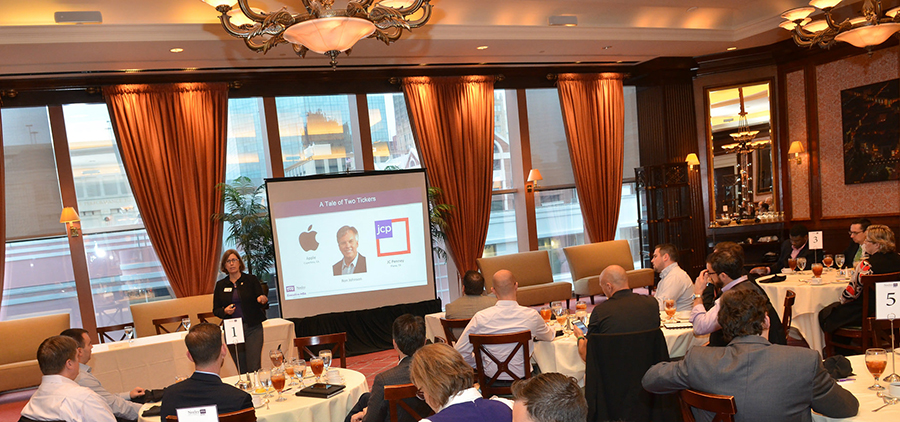Have you ever tried a sure-fire strategy – one you knew from experience would work – and then watched it blow up in your face?
That’s what a group of TCU Executive MBA alumni and prospective students discussed a couple of weeks ago at the Preview Luncheon at the City Club of Fort Worth. Dr. Suzanne Carter, professor of strategy, stood in front of the giant window overlooking a rainy downtown and presented us with two logos: Apple and J.C. Penney.
December 02, 2016
Have you ever tried a sure-fire strategy – one you knew from experience would work – and then watched it blow up in your face?That’s what a group of TCU Executive MBA alumni and prospective students discussed a couple of weeks ago at the Preview Luncheon at the City Club of Fort Worth. Dr. Suzanne Carter, professor of strategy, stood in front of the giant window overlooking a rainy downtown and presented us with two logos: Apple and J.C. Penney.
Challenged to identify what the two had in common, we mumbled amongst ourselves for a bit before settling on “retail.” The fact that we couldn’t immediately identify any other similarities turned out to be illuminating later on in the discussion.
But Dr. Carter pointed out one more commonality: Ron Johnson.

As senior vice president of retail operations at Apple for 10 years, Ron Johnson hit a home run helping pioneer the Apple Store and Genius Bar. The strategy saw huge success, recently achieving an average of $7,500 profit per square foot. Before that, Johnson helped turn Target into the popular brand it is today.
That kind of home run was exactly what the board at J.C. Penney needed when they hired Johnson as chief executive officer in 2011. JCP’s sales were suffering, and the brand needed a strategic change.
Everyone, including Johnson, was confident he could lead that strategic change. Johnson called the situation at J.C. Penney identical to Apple’s when he’d started there.
But – spoiler alert – it wasn’t.
Johnson immediately moved to make the JCP retail experience more like Apple’s. He eliminated coupons and most of the sales, touting everyday reasonable prices instead. He took the salespeople off of commission, so every customer could be sure to get the same treatment. He created mini stores-within-the-store to feature individual product lines.
But J.C. Penney let Johnson go after 17 months and losing nearly $1 billion in revenue.
How Did Johnson Fail to Lead Strategic Change?
So why did Johnson fail where he had succeeded before – and how can you avoid the same mistake?
- Pacing and urgency. It’s great to hire an outsider for a new perspective, but that outsider needs time to observe the company and understand its culture and its appeal before making changes. Apple had time for that kind of observation, research and testing before implementation. But J.C. Penney, panicked by falling revenue, rushed to make changes without due diligence.
- Resources and capabilities. Apple had money to spare, and could afford to risk losing a little if bold decisions didn’t pay out, or didn’t pay out right away. J.C. Penney was already losing money.
- Experience of leadership. Steve Jobs and Ron Johnson were a good team: Jobs knew the product and the customer; Johnson knew the customer experience. But at J.C. Penney, Johnson assumed he knew everything he needed to know. While the board was really expecting too much too quickly, Johnson was also promising too much, and letting his experience at Apple bias his understanding of what was happening at J.C. Penney.
Ultimately, the best of times at Apple turned into the worst of times at J.C. Penney because Johnson assumed the two were more similar than they were. He didn’t take the time to understand J.C. Penney’s core customer – a customer who craved the high of a sale and of seeing the amount they saved at the bottom of their receipt. He also failed to get buy-in from employees, who found themselves demotivated by the move away from commission sales.
Any one of us could fall into the trap that Johnson did, planning merely by intuition without drawing on solid data and running simulations first.
“Where can you learn how to run that kind of simulation?” someone asked with a raised hand.
Dr. Carter chuckled with a funny-you-should-ask-that tone and explained that simulations are part of the business analytics class in the Executive MBA program.
--
Find this enlightening? Join us for the next preview luncheon to enjoy more business insights and meet EMBA alumni, current students, prospective students and faculty.

